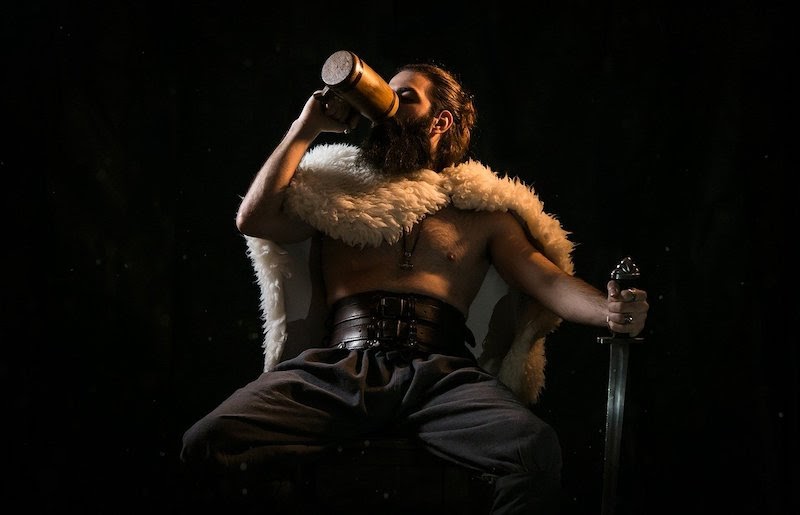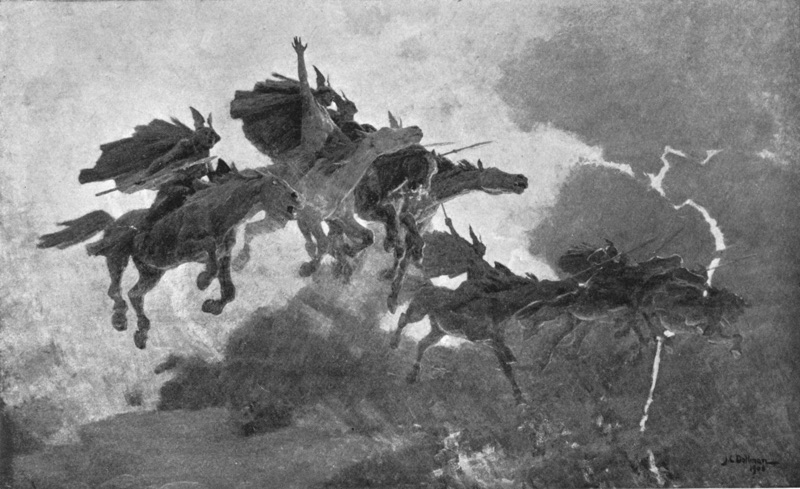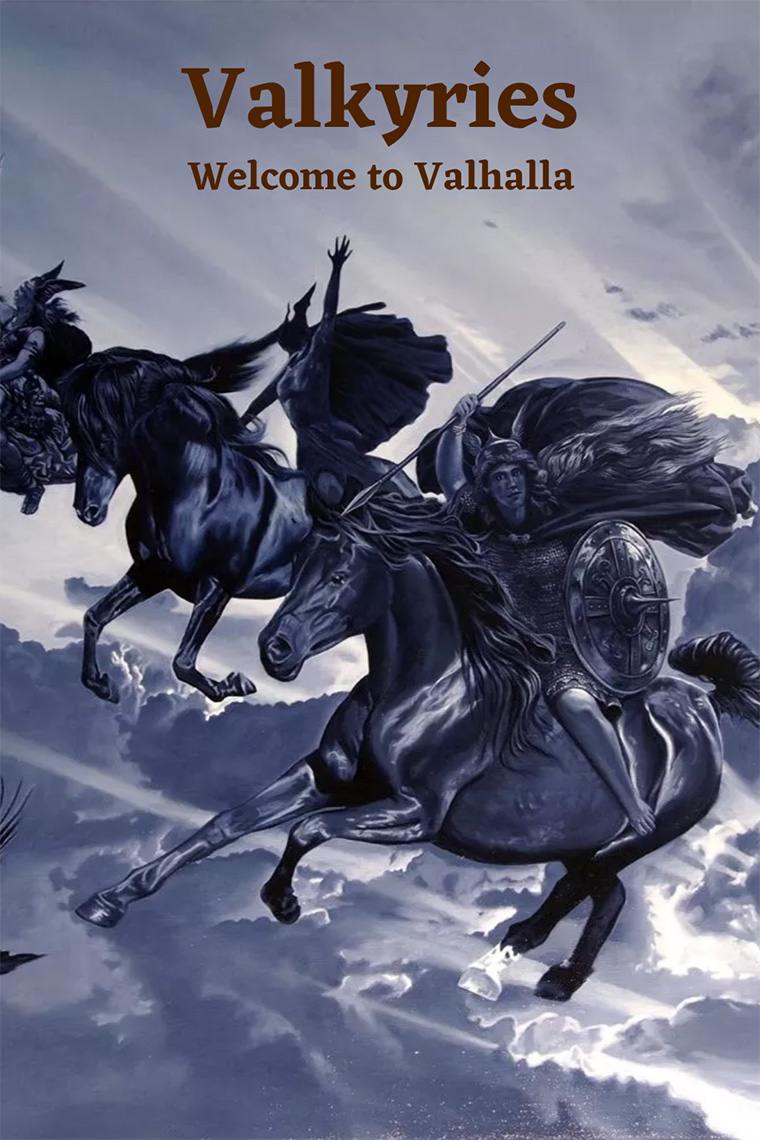Everything you need to know about Odin’s famous afterlife maidens, the Valkyries.
From opera to comic books, the Valkyries pop up all over our popular culture. These fierce maidens carry the warriors killed in battle to Valhalla. There they live a glorious afterlife, drinking mead and preparing to fight on Odin’s side at Ragnarok.

It all sounds rather pleasant, as afterlife myths go! But is there more to it than that? You bet! Read on to find out everything you need to know about the Valkyries.
Maidens of Valhalla
According to Norse mythology, warriors who die in battle end up in one of two places. Half go to join the Goddess Freyja in her heavenly realm of Fólkvangr.
The other half go to Valhalla, Odin’s glorious afterlife hall. It’s the job of the Valkyries to choose among them and bear them to Valhalla.
The Valkyries are usually depicted as beautiful maidens riding on horses through the skies over the battlefield. With shrieking cries they swoop down and take their pick of fallen men. They bear the bodies to Valhalla to spend eternity with Odin, waiting for Ragnarok.
Read more: The History of the Vikings
So what is there to do in Valhalla? Well, there’s plenty to keep a dead warrior, now known as a Einherjar (literally ‘army of one’ or ‘those who fight alone’), happy in their death. During the day they prepare for the events of Ragnarok, where they will fight in the battle at the end of days.

In the evenings, things get much more pleasant. The cook of the Gods, Andhrímnir prepares a feast from the slaughtered beast Særímnir, sometimes depicted as a boar. Once the warriors have had their fill, the beast is resurrected to be slaughtered again the following day!
In and amongst fighting and feasting they drink mead. But this is not just any old mead. This is mead from the udder of the goat Heiðrún, who makes mead by eating the foliage of the tree Læraðr.
What’s in a name?
The name Valkyrie comes from the Old Norse valkyrja, literally ‘chooser of the slain'. This in turn comes from valr, the slain on the battlefield and kjósa, the verb meaning to choose. So the name does exactly what it says!
Regular readers will know that most Norse mythology comes in the form of the Poetic and Prose Eddas, along with a few other Sagas and the Skaldic Poetry. Valkyries are mentioned throughout these texts, which is a sure sign of a strong legend.
Most of the names of the Valkyries relate strongly to the topic of war. Examples include Brynhildr – ‘armour battle’ or ‘bright battle’, Hildr – simply ‘battle’ and Eir – ‘peace, clemency’. We’ll be catching up with Hildr shortly as she plays quite a leading part in the Valkyrie legend.

Choosers of the Slain
The origins of the Valkyries are slightly unclear. Scholars debate whether they’re a true part of Norse mythology or a fairly modern addition. We’ll never know the true nature of how the Valkyrie myth came to be what it is but we do know it has some slightly unsavoury origins!
Perhaps one of the earliest ideas of the Valkyries was as demons of the dead. After a battle they’d pick over the corpses on the battlefield and choose the ones they liked the look of. Over time, when Valhalla changed from being a battlefield to a heavenly hall, the Valkyries may have morphed into the more pleasant image we have today.
Read more: Faith in the Viking Age
Perhaps more likely, many scholars have proposed that there’s a deeper meaning to ‘choosers of the slain’. Rather than simply picking amongst the dead, the Valkyries would observe the battle and decide which ones they liked the look of. These would then have their fate sealed.
This is where some of the confusion lies. The Old Norse legends already have the concept of The Norns, who decide the fates of men. It’s up for discussion whether the Valkyries had a similar function to The Norns, or whether the two roles merged together at some point in history.
What’s All the Fighting About?
If, like me, you’ve managed to live your entire life without being killed in battle, you might be wondering why so many Old Norse folk were less fortunate! After all, surely they can’t have been battling constantly? For one thing, you’re going to quickly run out of warriors!
For this we need to head to Hjaðningavíg, the “battle of the Heodenings” and our old friend Hildr.
According to legend, when the warrior Hǫgni was away, his daughter Hildr was kidnapped by a Prince named Heðinn. Hǫgni tracked Hildr down to an island, possibly Hoy in the Orkneys, and went with his men to rescue her.
Hildr welcomed her father with an offering of peace but Hǫgni was having none of it! He unsheathed his never-fail sword Dáinsleif and a battle ensued.

‘Thou hast made this offer over-late, if thou wouldst make peace: for now I have drawn Dáinsleif, which the dwarves made, and which must cause a man’s death every time it is bared, nor ever fails in its stroke; moreover, the wound heals not if one be scratched with it.’
A battle ensued and many men died. In the evening as Heðinn and Hǫgni returned to camp, Hildr remained on the battlefield and resurrected the men who started to fight anew. Thus began an eternal battle that would continue until Ragnarok.
Freyja the Valkyrie
You might be wondering why you need two separate heavenly halls for slain warriors. It’s a question that scholars have pondered for years too! One explanation is that Freyja herself is a Valkyrie and so she chooses half to join her in Fólkvangr.
Read more: Gods in Norse Mythology
Her hall is called Sessrúmnir (‘seat room’ or ‘room of many seats’) and this is also the name of a ship, so some think there may be some confusion as to its exact nature and purpose.
Another theory is that Freyja is simply the prototype of the Valkyries. As she rode into battle and chose half of the slain to join her in the afterlife, maybe Odin came along and thought ‘hmmm…what a great idea’!
As for why we need two afterlife halls for warriors, the most common theory is that it involves different forms of initiation for the warriors. Or it may simply be that both the Æsir and the Vanir need an army for Ragnarok.

Valkyries in Popular Culture
As I mentioned at the start, Valkyries have found their way into our culture. They're mentioned in Viking movies. They’re commonly mentioned in songs by Scandinavian bands. There’s even a Swedish Black Metal band called Valkyrja!
Here are a few examples of where you might have seen mentions of Valkyries.
Operation Valkyrie
The name Valkyrie was given to an operation to mobilise the reserve army of Germany in the event that allied bombing caused the civil order to break down. The operation was then co-opted into several attempts to stage a coup and oust the Nazis from power from within Hitler’s ranks.
The idea of the plot was to kill Hitler and then use Operation Valkyrie to mobilise the reserve army and then order them to start rounding up members of the Nazi party and the SS.
The closest it came to succeeding was on July 20th 1944. A bomb placed in Hitler’s Wolf’s Lair was detonated with Hitler in the room but (spoiler alert!) it failed to kill him.
Operation Valkyrie has been the subject of several films and documentaries as, among the many such plots, it came closest to killing Hitler. Most famously, the 2008 film Valkyrie, directed by Bryan Singer, starring Tom Cruise and Kenneth Branagh, does a pretty good job of showing how tense the operation was.
Ride of the Valkyries
The Romantic-era composer Richard Wagner wrote an opera called The Valkyrie – Die Walküre – telling the story of two twins Siegmund and Sieglinde, separated at birth, who meet and fall in love.

The Gods insist that Siegmund must die for this terrible act and the twins are only saved by the title character, the Valkyrie Brünnhildewho then faces the wrath of the gods.
The Valykrie is part of the Ring Cycle. These four operas, based loosely on Norse mythology that tell a story about a magic ring that shares some similarities with Tolkien’s The Lord of the Rings, a story also based loosely on Norse mythology.
The most famous part of The Valkyrie, known even to those who ‘don’t do classical music’ is The Ride of the Valkyries. It’s a rousing tune that leaves no one in any doubt as to the themes of battle and valour. The piece has been used in numerous films over the years, most famously in Francis Ford Coppola’s vietnam war epic, Apocalypse Now.
In the film, the music is blasted from helicopter loudspeakers as troops descend on a viet cong village. It serves the purpose of motivating the troops to get the job done and also to terrify the viet cong on the ground.
The Ride of the Valkyries is also the title of a painting by the Italian painter Cesare Viazzi, depicting spear-toting maidens riding their horses through the sky.
Valkyrie the Superheroine
In 1970, Marvel Comics introduced Valkyrie, a superheroine based on the Valkyrie Brynhildr. Also known by the name of Brunnhilde, Valkyrie usually rides a winged horse called Aragorn and carries an enchanted spear called Dragonfang. She is the leader of Odin’s shield maidens, the Valkyrior.
View this post on Instagram
As with most of the Asgardian adventures in Marvel Comics, Valkyrie’s stories are based heavily on the true sources of Norse mythology. They have covered the story of Siegmund and Sieglinde that’s in Wagner’s The Valkyrie as well as many of the other tales of Brynhilde’s heroic exploits.
On screen, Valkyrie was introduced into the Marvel Cinematic Universe in Thor: Ragnarok. Played by Tessa Thompson, Valkyrie first appear in Thor: Ragnarok as Scrapper 142. Thor recognises her as a Valkyrie and, eventually, she joins him in the fight to save Asgard.
Valkyrie returned in Avengers: Endgame and is slated to reappear in Thor: Love and Thunder.
Did you enjoy this post? If so, why not share it on Pinterest so others can discover and enjoy it too? We've got the perfect pin:



From, “The Teuton’s Battle Song” by H P Lovecraft, 1914:
The mighty Odin laughs upon his throne
And once more claims his children for his own
Armed valkyries ride out from the sky
Berserkers doing Godlike acts of bravery
Only warriors can feast with Odin
To attack or be attacked
The Gods are kindest to the strongest man
Why should we fear?
What greater joy than this?
Asgard will give us bliss
I can see the helmeted valkyries close to me
Ten more I slay
Odin’s mounted messengers are so near now
The darkness comes and I feel my spirit rise
A kind valkyrie carries me to the skies
( https://summary-of-odinism.blogspot.com/ )
hmmm. thinking. covid’s entering its second Winter so at 6am…
ah, anyway.
thinking of my different religions. and I think this fits in with a dominant Christian theme. Aside from that, I shall learn more but it’s obvious 🙂 Even in Valhalla, the practice all day is for Ragnorok. My opinion (subject to change) is Folkvangr is -as you say- a different level of initiation. Yeah, originally, folkvangr fighting alone is a longer-tempered vision! ha. those short-tempered “more Valiant” types decide to practice skills? thanks!